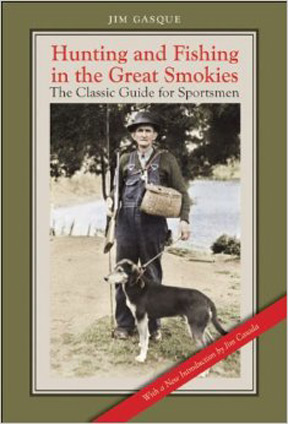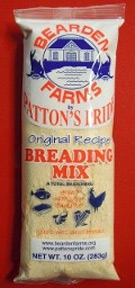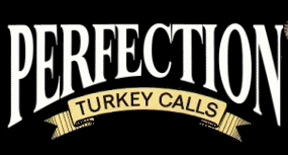|
December 2013 Newsletter
|
| Jim Casada 1250 Yorkdale Drive Rock Hill, SC 29730-7638 803-329-4354 |
Web site:
www.jimcasadaoutdoors.com |
Click here to view this newsletter in a .pdf with a white background for easy printing.
December Delights, Part II
It’s still not too late for some last minute Christmas shopping, especially if you pay a bit extra and get books shipped by flat-rate priority mail (phone or e-mail me for specifics). If you’ll look at my newsletter from the beginning of this month there are a bunch of suggestions and special offerings.
|
Jim’s Doings After a successful if hectic two days at the WNC Fly Fishing Expo, where I had a chance to talk with lots of good mountain folks, sign some books, and hopefully entertain and inform attendees with my seminars on Friday and Saturday, things are pretty well back to normal here. I’ll be doing quite a bit of deer hunting between now and when our season closes on January 1. Meanwhile, there are some writing assignments to be handled and of course all sorts of social and family activities connected with the holidays. I can’t move on from the WNC Fly Fishing Expo without first mentioning two things that happened at the event. One involved a fellow coming up, chatting a bit, buying some books, and then telling me he had made a “discovery” he wanted to show me. It turns out he was browsing in some flea market or antique store and came across a homemade rod case which had belonged to Jim Gasque. Most of you won’t recognize the name Jim Gasque, but he was a well-respected outdoor writer in the middle of the 20th century who had two books published in the renowned Borzoi Books for Sportsmen series done by Alfred A. Knopf. One of those works, Hunting and Fishing in the Great Smokies, has always been near and dear to my heart for the simple reason it is set squarely in my highland homeland and includes a full chapter devoted to a distant relative and man about whom I’ve written a great deal, legendary sportsman Mark Cathey. When the University of North Carolina Press reprinted the book a few years back, I wrote a new Introduction to it and provided a number of supporting photographs.
At any rate, the fellow left my booth and headed out to his vehicle to get the rod case and show it to me. A few minutes later he returned, and as soon as he showed me the case he dispelled one of my doubts; namely, whether the case had actually belonged to Gasque. There was no doubt on that score, because carefully painted at the top in gold lettering was “Jim Gasque, Asheville, N.C.” The case was a solid metal tube (probably aluminum) which had been carefully wrapped in thick cord wound tightly around it from top to bottom. It was also equipped with a carrying strap. I admired the case, suggested that it was a true museum piece, and mused a bit about how lucky he was to have found a little piece of Appalachian angling history of that sort. To my flat-out amazement, the gentleman said: “It’s yours. I greatly appreciate what you’ve done for the literature of fishing in this region and the fine Introduction you wrote to the reprint of Gasque’s book.” Quite simply, I was momentarily rendered speechless (something those who know me personally realize is anything but a standard state of affairs), and I’ve no doubt my eyes misted up a bit. It was a truly meaningful gesture which touched me deeply. Incidentally, I have a few copies of the reprinted version of Gasque’s delightful book on sport in the Smokies in stock, and signed, inscribed copies are $20 postpaid. Also, if you are a collector who wants the first edition, I’ve got three or four copies in varying condition, both with and without dust jackets, and you can contact me for prices. The original is fairly hard to come by thanks to the fact that less than 4,000 copies were every sold.
You can get details of this simple mix (just wet and bread not only fish but poultry, pork chops, shellfish, and okra) by visiting www.beardenfarms.org or www.pattonspride.com. My longtime buddy and fellow turkey hunting addict Jim Clay, of Perfection Calls, recently sent me a CD he and Kirk Gordon have put together on “How to Trick ‘Em.” It contains information on all sorts of unusual and offbeat tactics, including a short segment in which Jim shares something I used to take a turkey in difficult conditions while on a fall hunt with him many years ago. The overall information is first-rate (Clay is what my mentor, Park Whedon, liked to described as “a turkey killing machine”), and if you are interested check out www.PerfectionTurkeyCalls.com.
A good many months back I was asked to contribute a chapter on George Bird Evans, about whom I have written a few times over the years, to a major effort aimed at celebrating grouse and grouse hunting. Entitled A Passion for Grouse, the book is a veritable tome. I put it on the scales I use to weigh books for USPS shipment and it weighs just a few ounces short of six pounds. Its 550+ pages are chock full of lovely photographs and illustrations, fine vignettes of the sport’s icons, all sorts of extras such as grouse recipes and a bibliography of the sport’s literature, and a great deal more. No serious sporting bibliophile, and certainly no aficionado of the woodland drummer, can afford to be in a situation where this book does not grace their shelves. It is destined, in my studied opinion, to become a classic, and I’m delighted to have had a small role in the work. It is available only from the publisher, Wild River Press, and while I would have liked to be able to offer a few copies for sale, I applaud the Press and editor Tom Pero for the decision to eschew Amazon and all retail outlets. I do have one spare copy (contributors received two) available for $100 plus $10 shipping. Let me know if you are interested. |
The Goodness of Greens Sometime later today, once I’ve completed this newsletter, I’ll head out to the garden to harvest some winter goodness. Right now my fall/winter bounty includes mixed types of lettuce, cabbage, broccoli, kale, Swiss chard, and what mountain folks have always described with the simple term “greens.” In the case of my garden, those greens actually fall into three distinct categories. I’ve got old-fashioned curly top mustard, large leaf mustard, and purple top turnips. Many folks grow the latter strictly as a root crop, but to my way of thinking turnip greens are just as delectable as the roots.
Greens have always been a staple of mountain diet in the colder seasons, and they were standard fare on our family table when I was a boy. We probably ate them at least two or three times a week, and the way both Momma and Grandma Minnie prepared them remains my favorite means of preparation although it likely won’t satisfy the cholesterol Nazis (alas, my wife is a member of that clan). Preparation involved cutting several slices of streaked meat, frying it in a cast iron skillet, and using the grease thereby produced as seasoning for the greens as they cooked. Sometimes, instead of frying the meat the slices would be cooked directly with the greens. I preferred the former approach simply because one of those crisp, crunchy slices of fried streaked meat (also called side meat or fat back), placed inside a piece of cornbread, made the perfect accompaniment for a mess of greens. Indeed, often that would be the only meat we had in a meal which featured greens, cornbread, pinto or October beans, and canned apples. Momma liked to mix mustard and turnip greens when she cooked them, and she had two distinct approaches when it came to the actual root portion of the turnip. Sometimes she would dice it quite thin and cook it with the greens; on other occasions she stewed the turnips separately and once they were done topped them with a bit of butter along with salt and pepper. My oh my, was that ever fine eating. Grandpa Joe loved his greens, and he had an interesting way of eating them. He would get a hefty helping of the greens and place in his plate, but that was only part of the culinary attention he devoted to greens. Once he had a satisfactory sized helping (which mean a whopping one, because he was flat-out a first-rate trencherman, never mind being slender and tough as a seasoned hickory stick), there remained a second dish associated with the greens. He would crumble cornbread up in a bowl and pour a liberal splashing of pot liquor from the greens over it. Although it never occurred to me at the time, I suspect he was getting the best of the vitamins and nutrition in the greens in the pot liquor. I’ll relive some of that simple feasting from boyhood later today, although I’ll probably skimp a bit when it comes to the pork seasoning and use lean, low sodium bacon instead of fatback. That will keep martial harmony somewhat on an even keel, and while fancified bacon ain’t fatback, no matter how you look at it, I reckon I’ll have to acknowledge it’s better for those of us who lead a life which is far more sedentary than what was the case two or three generations ago. After all, Grandpa Joe did manual labor from dawn to dusk six days a week, and that hard work more than offset any negatives associated with the kind of foodstuffs he liked to have on the family table. Recent Reading As I’ve probably made abundantly obvious over time, my reading interests are rather eclectic. Right now, after a concerted spate of enjoying several books featuring Vince Flynn’s character, Mitch Rapp, and the combined efforts of Lincoln Child and Douglas Preston in their series involving the exploits of Aloysius Pendergast, I’ve turned to historical novels. A week or two back I stumbled across a list of 50 top works in the field and perused it to see how many of the books I had read. I was conversant with 20 or more of them, but that left plenty of elbow room. It might also be noted that, no doubt predictably, I found fault with the list. How Wilbur Smith could be left off was beyond me, for the historical settings of his African-based works are invariably spot on. Similarly, I was disappointed to see no mention of George Macdonald Fraser’s rollicking series starring that irresistible scoundrel, Flashman. Still, my recent reading includes some dandies. M. M. Kaye’s The Far Pavilions (I had read several of her “Death in . . .” mysteries but not this massive magnum opus, which must be two and a half inches thick and runs to just short of a thousand tightly written pages), Margaret Atwood’s Alias Grace, Patrick DeWitt’s The Sisters Brothers,and Guy Vanderhaeghe’s The Last Crossing have been on my list, with Ken Follett’s The Pillars of the Earth, Willa Cather’s Death Comes for the Archbishop, James Michener’s Caravans, and Joseph Boyden’s Three Day Road lying in wait. This Month’s Author: Rudyard Kipling Continuing the theme from my mid-November newsletter, I’m going to opt for another poet, Rudyard Kipling. Of course Kipling wrote far more than poetry, as novels such as The Light That Failed, Kim (the work was autobiographical in nature), and Captains Courageous suggest. Then too, he was a master of the short story, and to delve into collections such as The Jungle Book, Plain Tales from the Hills, Just So Stories, or Stalky & Company is to be transported to a world of wonder. Kipling was born in India and much of his finest work is set there. Yet the compass of his writings went well beyond that sub-continent, embracing the British Empire at its peak and offering an unapologetic view of the grandeur of imperialism. I personally find many of his poems enchanting. Part of that comes from their rhythm, for Kipling didn’t write what my contrarian mind views as “lazy” poetry (that where rhyme, meter, and often, meaning, are sadly missing or else beyond the ability of my weak mind to discern). Kipling didn’t just write poetry; he wrote verse, and he did it in a fashion which moves one’s soul even as he captures the heart. If you doubt this, read (preferably aloud, which is the best way to get the full impact of his words) poems such as “Gunga Din,” “Recessional,” “If,” “Fuzzy Wuzzy,” “The Ballad of East and West,” or “The White Man’s Burden.” He was masterful with dialect, such as that of the Cockneys with dropped aitches in “Fuzzy Wuzzy,” and he understood India in a fashion rivaled by few if any Englishmen. In today’s world, obsessed by political correctness, Kipling’s popularity has declined immensely and he is a decidedly controversial figure. For my part, and I don’t think I’ve ever been accused of being either politically correct or particularly diplomatic, his stuff is pure delight. Many of you probably haven’t delved into Kipling since school years, but I would heartily recommend getting reacquainted. |
Thank you for subscribing to the
Jim Casada Outdoors
newsletter.
Feel free to contact Jim with your comments, questions
or suggestions at jc@jimcasadaoutdoors.com.
Send mail to
webmaster@jimcasadaoutdoors.com with
questions or comments about this Web site.
Copyright © 2004-2011 JimCasadaOutdoors.com. Last modified:
12/16/13.
Web site design by
Wordman, LLC

 The other development centered on mountain food lore (in that
general subject area, see the coverage of “greens” at right). An
attendee looked at some of the cookbooks I had on display and we
talked a bit about frying fish and other matters related to
outdoor cookery. He then reached in a little day pack he was
carrying and brought out two containers of breading mix. It is
known as “Patton’s Pride” original recipe breading mix and is
sold under the Bearden Farms label.
The other development centered on mountain food lore (in that
general subject area, see the coverage of “greens” at right). An
attendee looked at some of the cookbooks I had on display and we
talked a bit about frying fish and other matters related to
outdoor cookery. He then reached in a little day pack he was
carrying and brought out two containers of breading mix. It is
known as “Patton’s Pride” original recipe breading mix and is
sold under the Bearden Farms label. 
